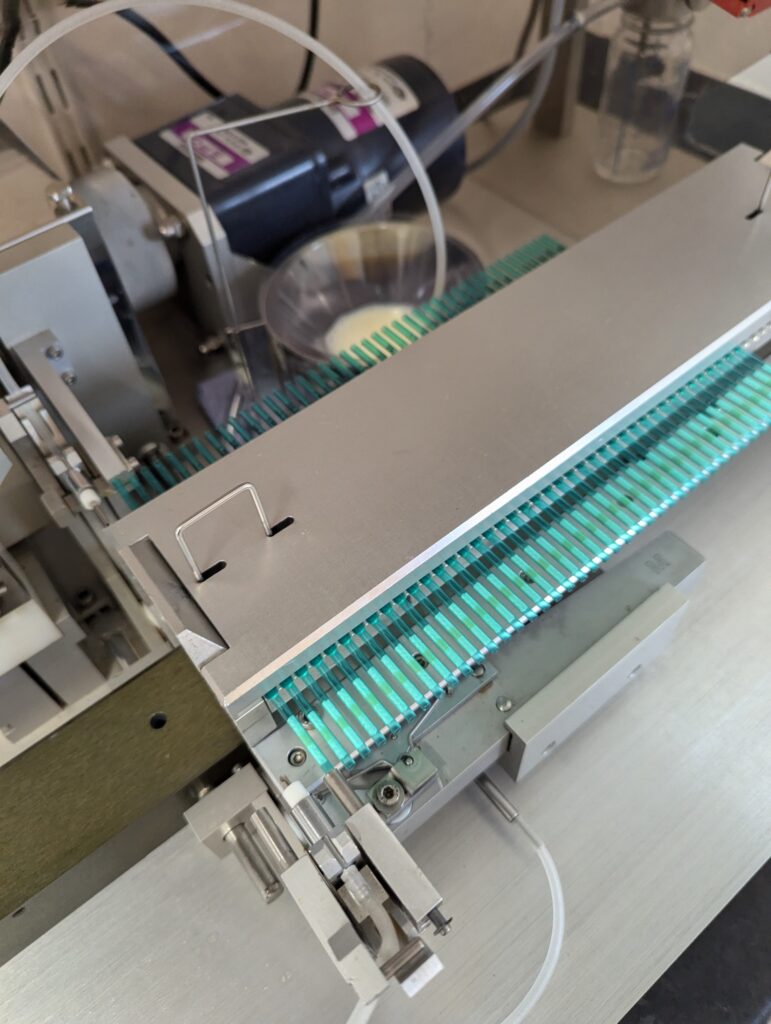BREEDING FOR EXCELLENCE – The benefits of freezing stallion semen
Breeding Webinar Series – No. 1
Questions taken from a Q&A Session during a recorded webinar on Wednesday, 25th September with West Kington Stud Manager, Harry Thirlby, B&W Equine Reproduction Vets, Chris Shepherd BVSc MRCVS and Anna Mitchell BVM&S DACT MRCVS and guest speaker, International Event Rider, Nick Gauntlett.

Q1: How do you select a mare to be a good candidate for frozen semen?
A: (Chris Shepherd) We’re sometimes a little bit selective when we’re working with frozen semen or advising clients which mares to use. We try to avoid so-called ‘problem’ mares, who’ve had issues getting in foal in previous years. Although conception rates with frozen semen are equally as good as chilled, if not better (and the statistics confirm that), we have to admit that there are various reasons why, for problem mares, it can be more useful to use fresh semen (i.e. semen collected and inseminated into the mare within an hour or two). So, as far as our selection goes for suitable candidates for frozen semen, mares of an appropriate age and with an appropriate breeding history is really what we’re looking for.
Q2: How many straws would be created from one collection?
A: (Harry Thirlby) This is a bit of a ‘how long is a piece of string’ question, as it varies wildly depending on many factors. For instance, very young stallions and the majority of ponies would typically give us a much smaller number of straws. If we were really generalising, as an average we’re probably looking at ending up with 50 to 100 straws from a collection. We’ve had some sensationally good collections where we’ve ended up with 250, but they’re very, very rare and, at the other end of scale, we’ve had little Exmoor ponies, who might only give you five or six straws. So there is a huge level of variance, but I would think maybe 50 to 80 would be fairly typical.
(Anna Mitchell) I agree, and would also like to point out that, for anyone who is not clear, that the breeding dose will involve multiple straws, so we’ll work out how many straws we need to give 300 million progressively motile sperm. On average that will be five to eight straws, depending on the quality of the semen.
Q3: How old is ‘too old’ for a stallion?
A: (Anna Mitchell) I wouldn’t put an actual age on it but basically, at some stage, fertility will start declining with age and there will be some testicular degeneration. But when these changes start result in subfertility/failure to get mares pregnant, really depends on the individual. We’d have numerous stallions that have collected and achieved good pregnancy rates at West Kington that have been well into their 20s (and I’m sure Harry can give more details on that) but I’d say it’s very much based on the individual. The other very important aspect, other than semen quality and fertility, is the orthopaedic comfort of these old stallions, because that’s often a limiting factor of to as to how happily they’ll collect. Chronic pain can affect the semen quality and quantity but also just actually them comfortably getting on the dummy and ejaculating.
(Harry Thirlby) I would say probably the oldest stallion I can think we’ve collected and frozen well from, in recent history, was 25. Obviously, he was just a very fit, well and healthy stallion. I think, as Anna says, what we’ve found more and more is, even in stallions that come back to us, it does tend to be more the body that can struggle keeping up with the collecting than necessarily always the semen quality. However we certainly have had situations when stallions, who were incredibly fertile in their youth, come back at 19 or 20 years old and really struggle. So I think, like with everything, it’s very much down to the individual but certainly we do quite frequently collect from 21-22 year olds and largely still get good results.
Q4: Why is stallion semen stored in multiple separate straws whereas this is not the case for bulls?
A: (Chris Shepherd) Post-thaw motility of bull semen is probably higher than most stallion semen and therefore you can get the required number of progressively motile sperm into one straw quite easily with bull semen. With stallion semen, in most cases, we’re having to freeze what we call a ‘dose’ in multiple straws.
Q5: Are there special processes required to prepare frozen semen for insemination?
A: (Chris Shepherd) It’s reasonably straightforward. We thaw it at 37 degrees C. It’s important that it’s exactly that temperature, or certainly no higher than that temperature. We usually use water baths, set at exactly that temperature, to thaw the semen in, but you don’t have to have a water bath, you can just make it up with hot and cold water in a polystyrene container and measure the temperature until you’ve got it at 37 degrees. We thaw them for a minimum of 30 seconds but, as long as the temperature is no higher than 37 (i.e. body temperature), they can actually stay in the water bath for a minute or two, while each straw is being inseminated.
Q6: How many stallions are available frozen at West Kington Stud?
A: (Harry Thirlby) I believe we are just shy of eight 800 different stallions stored here. This figure represents the most enormous range of breeds and types, from the smallest to the biggest, in every colour, shape, size and variety.
Q7: How many people are needed for a collection?
A: (Harry Thirlby) We would want not less than four people. The actual collection requires three people, so that works on the theory that there’s a fourth person waiting in the lab for the semen to arrive. We would have one person handling the stallion, one person handling the teaser mare and one person holding the AV. So generally, we would use four people for a collection, unless we have a particularly tricky stallion that wants three teaser mares parading around in front of him, and then we’d need some more
people to help.
Q8: Should it be standard practice to have all mares endo swabbed before frozen insemination?
A: (Anna Mitchell) B&W include an endometrial swab as part of our package because it’s an extremely useful diagnostic tool which we routinely do. With a very young maiden we might not, but generally we always would, and I think it’s extremely useful to maximize success rates. We can look for inflammatory cells as well as bacterial growth. Sometimes bacteria can be dormant and not necessarily be detected on a single swab so unfortunately it doesn’t necessarily mean that’s going to detect every problem but certainly I think it’s really useful. With thoroughbreds we swab them for venereal pathogens as well, which I don’t think is necessary for all mares that are going to be inseminated, but certainly just from a diagnostic point of view I think it’s pretty useful.
Q9: Is it still possible to export to Europe post-Brexit?
A: (Harry Thirlby) Certainly, post-Brexit, it is not as straightforward as it used to be. We have varied results, depending on the knowledge and experience of the people in customs at the port in which the semen arrives. We have found, largely speaking, anything we send to France that goes through Paris airport gets there just as quickly and easily as it did pre- Brexit. If we’re sending semen to places where there would typically be less semen arriving, it can be very, very difficult because you can be met by people who have no real understanding of what it is they’re looking at, or how to handle it. So, with anything going somewhere more obscure, we do generally now recommend that it is driven where possible, or flown on a specific flight. So, rather than sending it with a courier we’d use a freight forwarding agent who would deliver it specifically to the port Health wherever it’s arriving um that is sadly more expensive but we’ve had very very good success getting things through on that basis I think it’s just it’s very important that there’s someone the other end you can talk to ultimately
Q10: How long would a stallion have to stay to freeze for Europe?
A: (Harry Thirlby) That depends which testing programme gets followed. There isn’t necessarily a minimum time limit actually to freeze for Europe because we can make the semen eligible by doing pre-entry and post-collection health tests. So there is actually no minimum time period, it is just a case of allowing enough time to get the stallion here, get him flushed out, get him collecting and freeze a sufficient number of doses. Typically, you would expect it to take a minimum of a week to ten days to get everything in action and get the semen frozen.
(Anna Mitchell) And then you would just have to do the post-collection health test once you get the stallion back home.
Q11: Why is the Missouri more widely used than the Colorado system
A: (Harry Thirlby) The main reason is that they are probably just easier to purchase. They are certainly more user friendly – they are lightweight and easier to handle than the large Colorados which, if you really fill them up, can take eight nine litres of water. Holding that up, with a powerful stallion behind, is is quite the workout for the person collecting! So I think on that basis, the Missouri are just much easier.
(Chris Shepherd) I would agree on that, and it’s always our starting point with any new stallion, in the hope that they will be happy with the Missouri. It’s easy and quick to assemble, easy to fill and is so much lighter and those are generally the reasons that the Missouri is our first choice.
With many thanks to our panel of experts, who joined us on this webinar to share their knowledge and expertise on this subject.
If you missed the live session and would like more information on this topic, you can still watch the full webinar on our YouTube Channel.
____________________________________________________________________________________________________

